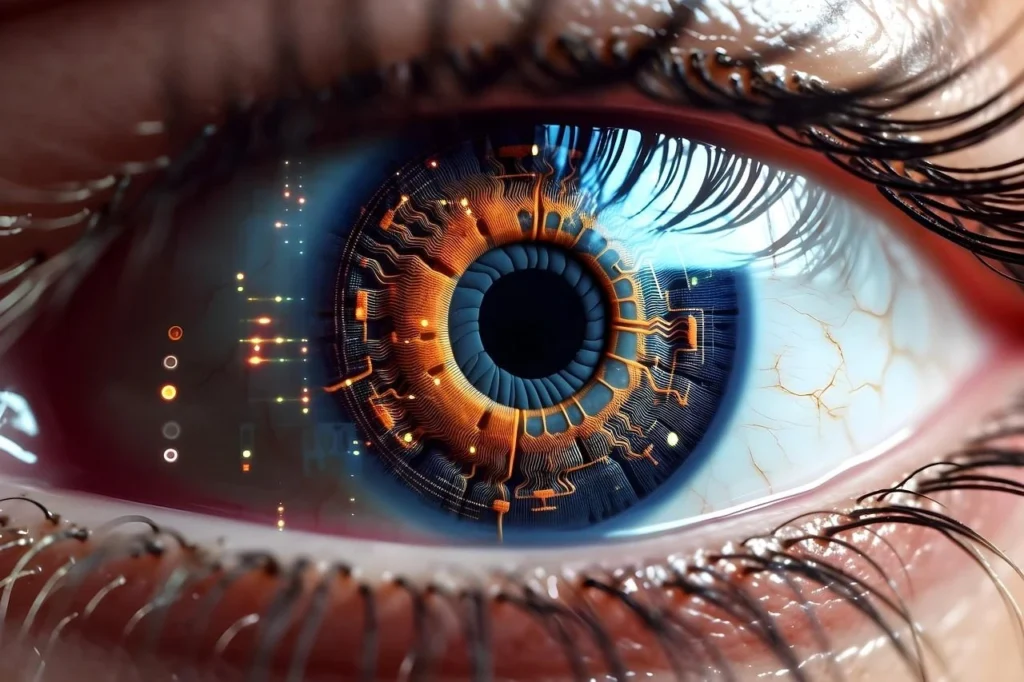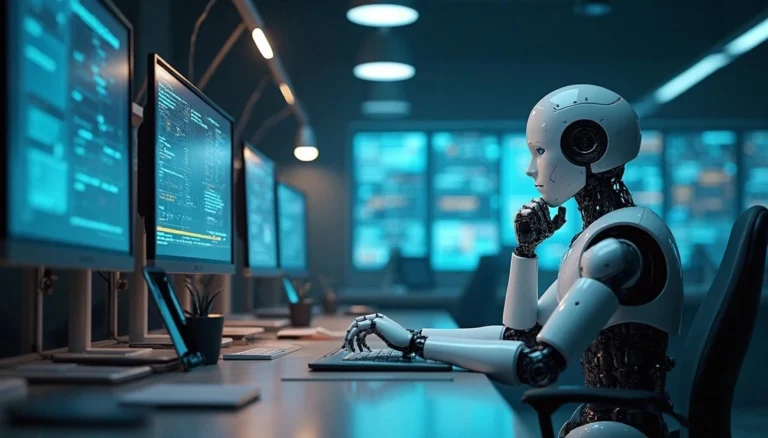
. That’s not a typo—the increase was real and rapid. Artificial Intelligence is expected to add $4.4 trillion to the global economy annually, which gives you some idea of why everyone’s suddenly paying attention. Generative AI usage among business leaders jumped from 55% to 75% in just one year
Here’s another notable statistic: searches for “AI note-taking” have skyrocketed by 8,800% in the last five years. People are clearly trying to figure out what AI can actually do for them. And the answer is quite a lot—AI can now automate between 60% and 70% of employees’ time on work activities.
In simple terms, it’s technology that lets computers perform tasks that usually require human intelligence. Think pattern recognition, decision-making, and predictions. Pretty straightforward concept, but the applications are getting wild.
Take healthcare, where Goldman Sachs estimates that , potentially saving over $360 billion annually. More than 650 AI-enabled devices have already received FDA approval, which means this stuff is already affecting patient care in real ways.28% of work done by healthcare practitioners could be automated by AI
But here’s the thing: learning AI still feels overwhelming for most beginners. The technical jargon, the math, the programming—it can seem like you need a computer science degree just to get started.
You don’t.
This guide breaks down the fundamentals of AI, gives you practical starting points regardless of your background, and looks at where AI is headed through 2025 and beyond. Whether you’re curious about how AI works in computer systems or just wants to understand what all the fuss is about, this roadmap will help you navigate what’s happening in AI without becoming overwhelmed by complex technical details.
What is Artificial Intelligence and How Does It Work?

Image Source: https://pixabay.com/
Artificial intelligence is computer systems designed to perform tasks that typically require human intelligence. At its core, it’s the science of creating machines capable of simulating human learning, reasoning, problem-solving, and decision-making. Unlike conventional computing, enables machines to learn from experience, adapt to new inputs, and perform human-like tasks without explicit programming. artificial intelligence technology
Traditional software follows instructions.
AI vs. traditional software
Traditional software operates on explicit, rule-based logic programmed by developers for specific scenarios. If a marketer wants to target an audience, a programmer manually crafts the necessary query. Everything is predetermined.
AI systems use data to find patterns and make decisions instead of following rigid rules. They learn autonomously from data and experiences, improving over time without human intervention. This represents a significant shift from conventional software that cannot adapt without manual updates.
Here’s how they compare:
Feature Traditional Software AI Systems Learning ability No ability to learn; behavior predetermined <citation index=”4″ link=”” similar_text=”Feature Adaptability Requires manual updates to adapt Automatically adjusts to new data Error handling Errors must be manually fixed <citation index=”4″ link=”” similar_text=”Feature Data processing Works with structured, well-defined data <citation index=”4″ link=”” similar_text=”Feature Decision-making Follows explicit, predetermined rules Makes decisions based on patterns in data What is artificial intelligence technology?https://www.geeksforgeeks.org/artificial-intelligence/what-is-artificial-intelligence-ai-and-how-does-it-differ-from-traditional-programming/https://www.geeksforgeeks.org/artificial-intelligence/what-is-artificial-intelligence-ai-and-how-does-it-differ-from-traditional-programming/https://www.geeksforgeeks.org/artificial-intelligence/what-is-artificial-intelligence-ai-and-how-does-it-differ-from-traditional-programming/
AI technology encompasses various subfields working together to simulate human intelligence. Machine learning, a critical component, allows systems to learn from data without explicit programming. The algorithms improve through experience, similar to how humans learn.
Deep learning uses to process information through multiple layers. These networks mimic the human brain’s structure, allowing AI to identify complex patterns in massive datasets. Neural networks analyze data repeatedly to find associations and interpret meaning from undefined data. artificial neural networks
Other key technologies include natural language processing (computers understanding human language), computer vision (interpreting visual information), and cognitive computing (designed to imitate human-machine interactions).
What is artificial intelligence in computer systems?
AI works by combining large datasets with intelligent, iterative processing algorithms to learn from patterns in the data they analyze. Each time an AI system processes data, it tests its performance and develops additional expertise.
The process typically involves a training phase where massive amounts of data are applied to mathematical models or algorithms. These algorithms recognize patterns and make predictions. Once trained, AI systems can be deployed in various applications where they continue learning from new data.
AI is enabling computers to perform complex tasks like image recognition, language processing, and data analysis with increasing accuracy over time. Unlike traditional computing that requires explicit instructions for every scenario, AI can handle unpredictable circumstances and adapt accordingly.
The bottom line: AI represents machines that not only execute commands but learn, adapt, and improve through experience. It’s changing how computers interact with and solve problems in our world.
How to Start Learning AI as a Beginner
“The best way to learn about anything is by doing.” — Richard Branson, Founder of Virgin Group, influential entrepreneur and business leader
You have multiple ways to get started with AI, depending on your background and how deep you want to go. Some people jump straight into coding, others prefer visual tools, and many start somewhere in between.
No-code and low-code AI tools
If you want to experiment with AI without writing code, are your best bet. These platforms let you build and deploy AI models through drag-and-drop interfaces and guided wizards. Think of them as the website builders of the AI world—you can create sophisticated applications without technical expertise. no-code AI tools
No-code AI tools offer three main advantages:
- Anyone can use them, regardless of programming background
- You can build AI applications quickly
- They’re cost-effective compared to traditional development
Popular platforms include PyCaret for machine learning workflows, DataRobot for business applications, and RunwayML for creative AI projects. These tools are particularly useful for understanding how AI works in practice without getting bogged down in technical details.
Learning Python and machine learning basics
For a deeper understanding of AI, Python is your gateway language. It’s become the go-to choice for AI development because it’s relatively simple to learn and has powerful libraries. If you’re going this route, you’ll want to get familiar with these essential tools:
- NumPy for numerical computations
- Pandas for data manipulation
- TensorFlow and PyTorch for building neural networks
- Scikit-learn for machine learning algorithms
You’ll also need some foundational math—statistics, probability, and linear algebra form the backbone of AI systems. Don’t worry if math isn’t your strong suit; you can pick up these skills as you go.
Free and paid resources to get started
There’s no shortage of learning materials out there. DeepLearning.AI’s “AI for Everyone” builds foundational knowledge in just six hours. Google’s “AI Essentials” focuses on practical applications you can use right away.
For more structured learning, Coursera offers AI certificates through university partnerships. There are also specialized programs like “AI Python for Beginners” that teach coding with AI applications from day one. What’s cool about this course is it uses an AI chatbot to provide immediate feedback, helping you debug code and learn more efficiently.
The University of Helsinki’s “Elements of AI” deserves special mention—it’s free and has attracted from 170+ countries. About 40% of students are women, which is more than double the average for computer science courses. over 1 million students
The point is, regardless of your starting point, there’s a path forward that works for you.
Where AI is Used Today: Real-World Examples
AI isn’t just a concept anymore—it’s actually doing work across pretty much every industry you can think of. The mobile AI market is projected to jump from $2.14 billion in 2021 to $9.68 billion by 2027. That’s a lot of phones getting smarter, fast.
AI in business and customer service
Customer service is where AI has become highly effective in this area. AI agents can now handle up to 80 percent of customer interactions, which means human agents get to focus on the tricky stuff instead of answering “What’s my account balance?” for the thousandth time.
Here’s what AI is actually doing in customer service:
- Running 24/7 support without anyone needing to pull night shifts
- Analyzing language cues and sentiment to understand if customers are frustrated or happy
- Routing complaints to the right person instead of being redirected multiple times unnecessarily
- Suggesting products based on what you’ve bought before
Unity deployed AI agents that handled 8,000 support tickets, saving them $1.30 million in the process.
AI in finance and fraud detection
Banks have gotten really good at spotting fraud, and AI is a big reason why. JP Morgan saw “lower levels of fraud, better customer experience and a reduction in false positives” after implementing their AI detection system in 2021.
AI watches for weird patterns—like your credit card suddenly being used for expensive purchases in a country you’ve never visited. It’s also monitoring blockchain transactions and tracking potentially stolen payments.
American Express improved their fraud detection by 6% using advanced AI models, while PayPal boosted their real-time fraud detection by 10%. These systems operate continuously, 24/7, which is exactly what you want when someone’s trying to steal your money.
AI in creative fields like art and music
AI has made it possible for people without traditional creative training to produce professional-quality work.
The global art market recognized the innovation when an AI-generated painting called. In music, The Beatles’ final “new” song “Now and Then” used AI to isolate John Lennon’s voice from a noisy old demo recording. Sony’s AI software even composed “Daddy’s Car” by studying and mimicking The Beatles’ style. “Portrait of Edmond de Belamy” sold for $432,500 at Christie’s auction
Musicians can now generate backing tracks in seconds, synthesize vocals, and separate different elements from the same recording. It’s not replacing human creativity—it’s giving creative people new tools to work with.
What’s Next for AI: 2025 and Beyond
AI isn’t slowing down—if anything, it’s accelerating. AI has progressed beyond experimental stages fiction. It’s embedded in daily operations across industries, and the pace of change shows no signs of letting up.
Current trends in artificial intelligence
Right now, we’re seeing AI shift from narrow, single-purpose tools toward more versatile systems. Generative AI has matured significantly beyond those early ChatGPT demos. Today’s AI can handle text, images, and code simultaneously, creating what researchers call “multimodal systems” that process different types of data at once.
I’ve found the business applications particularly striking. AI is making autonomous decisions in critical operations—not just recommending actions, but actually taking them. Meanwhile, specialized AI chips are dramatically reducing both power consumption and processing time, making AI more practical for everyday use.
The hardware improvements alone are worth paying attention to. We’re seeing AI capabilities that would have required massive data centers just a few years ago now fitting into consumer devices.
What is the AI trend in 2025?
Three major trends are shaping AI in 2025:
First, ethical AI frameworks have become mandatory in major markets. Companies can’t just deploy AI anymore without addressing bias detection and transparency—regulators are paying attention.
Second, AI development has been democratized. Non-specialists can now create customized AI applications using platforms that don’t require programming expertise. This is huge for adoption.
Third, edge computing is bringing AI directly to devices rather than relying on cloud processing. This reduces latency and addresses privacy concerns—your data doesn’t have to leave your device.
Human-AI collaboration rather than replacement. AI is enhancing human capabilities across healthcare diagnostics, creative design, and knowledge work rather than simply automating jobs away.
The future of artificial intelligence in society
Looking ahead, AI will reshape how society operates, though exactly how remains an open question. Artificial general intelligence—systems with human-like reasoning across multiple domains—remains the industry’s ambitious goal, even if timeline predictions vary wildly.
Employment landscapes will certainly change as automation extends into knowledge work. But this disruption is creating new opportunities in AI oversight, ethics, and human-AI interface roles. The key is preparing for these shifts rather than ignoring them.
AI will also become more personalized as systems develop deeper understanding of individual preferences and needs. The challenge is managing this personalization with privacy and avoiding the creation of information bubbles.
Ultimately, depends on how well we balance technological advancement with ethical considerations and human-centered design. The technology is advancing rapidly—the question is whether our frameworks for managing it can keep pace. what’s next for AI
Challenges and Ethics in Learning AI
Learning AI isn’t just about understanding the technology—it’s about addressing complex, real-world challenges. that come with it. These ethical challenges aren’t theoretical concerns for the distant future. They’re happening right now, and anyone serious about AI needs to understand them.
Bias and fairness in AI systems
AI systems can perpetuate and amplify existing biases in ways that might surprise you. Take text-to-image models like StableDiffusion and DALL-E. When prompted to generate images of “CEOs,” they predominantly produced images of men. Ask them to generate images of criminals, and they overwhelmingly produced images of people of color.
These aren’t random glitches—they’re systematic problems that reflect the biases present in training data, algorithm design, and human interpretation.
The real-world consequences can be severe. The COMPAS system used in the U.S. criminal justice system was found to be biased against African-American defendants, who were more likely to be labeled as high-risk even without prior convictions. When AI systems make decisions about people’s lives, these biases matter in ways that go far beyond technical accuracy.
Environmental impact of AI computing
Here’s something most AI tutorials don’t mention: training large AI models requires staggering amounts of electricity. Training GPT-3 produced —equivalent to 123 gasoline-powered vehicles driven for a year. 552 metric tons of carbon dioxide
It gets worse. AI systems need substantial water for cooling, with estimates suggesting each kilowatt hour of energy a data center consumes requires two liters of water. Data center electricity consumption rose to , making them the 11th largest electricity consumer globally. By 2026, this is expected to approach 1,050 terawatts. 460 terawatts in 2022
These numbers matter because every AI model you train, every query you run, contributes to this environmental cost.
AI regulation and responsible development
The regulatory landscape is evolving quickly, but it’s complicated. AI used in video games needs different oversight than AI used in critical infrastructure. The Equal Employment Opportunity Commission has already warned that AI models in hiring and performance monitoring can produce discriminatory results that violate federal law.
Responsible AI development involves principles like transparency, fairness, reliability, privacy, and inclusiveness. Many organizations are establishing dedicated offices for responsible AI to oversee ethics and governance, implement monitoring tools, and provide training on ethical principles.
The bottom line: learning AI means learning to navigate these ethical challenges, not just the technical ones.
Conclusion
AI isn’t going anywhere. If anything, it’s accelerating faster than most people expected.
We’ve covered a lot of ground here—from the basics of how AI actually works to the real-world applications that are already changing how businesses operate. You don’t need to be a computer scientist to understand or use AI effectively.
If you’re just getting started, pick one path and stick with it for a while. Maybe that’s experimenting with no-code tools to see what AI can do without any programming. Maybe it’s diving into Python and machine learning fundamentals. Both approaches work, but A steady learning path is more effective than constantly switching approaches between different learning methods.
The real-world examples we looked at—customer service automation, fraud detection, creative applications—show that AI is already integrated into many commonly used systems. you probably use every day. Understanding these applications helps you see where opportunities might emerge in your own field.
But here’s what I think is most important: the ethical considerations we discussed aren’t just academic concerns. Bias in AI systems, environmental impact, and responsible development practices will shape how AI evolves over the next few years. Anyone learning AI should understand these challenges alongside the technical capabilities.
Looking ahead, AI will get more sophisticated, but it will also become more accessible. The tools will get better, the barriers to entry will get lower, and the applications will get more diverse. What won’t change is the need for people who understand both what AI can do and what it shouldn’t do.
The best way to really grasp AI is to start using it. Pick a tool, tackle a small project, see what works and what doesn’t. You’ll learn more from one hands-on project than from reading a dozen articles about AI theory.










